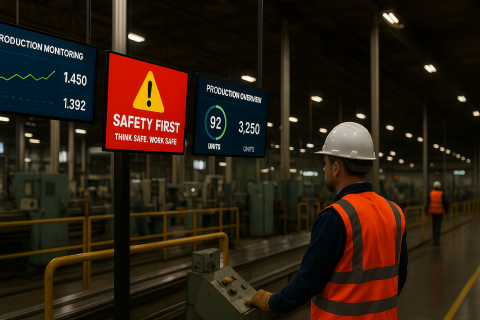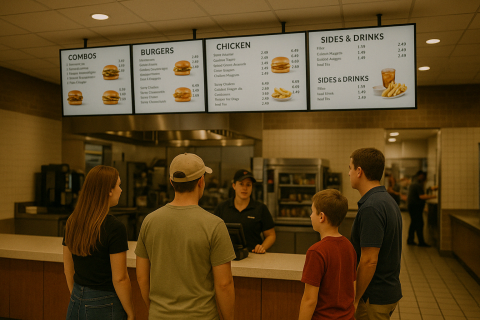Digital signage is a dynamic and versatile communication medium that businesses use to engage customers and employees. From retail stores to corporate offices, digital signs are everywhere – displaying menus, advertisements, dashboards, and more. When it comes to digital signage installation, many people assume they must hire specialized digital signage installation companies or invest in complex hardware. In reality, modern digital signage solutions have made it easier than ever to set up displays yourself, even offering no-hardware options that run on screens you already own. In this post, we’ll explore what’s needed for a digital sign, how digital signage installation services fit in (and when they don’t), and how Screenly’s approach makes implementing digital signs simple and approachable for anyone.
Components of a digital signage solution
Setting up a digital sign is straightforward. You typically need three components: a screen, a digital signage player, and digital signage software. The screen is the display for your content – this could be any standard TV or monitor. The player is a small device (or app) that displays media on the screen by rendering your images, videos, or web pages. Lastly, the software is the platform or content management system where you upload and schedule content to play on your screens.
Screen (Display): Almost any modern display will work as a digital signage display. If it’s a TV or monitor with an HDMI port, you can use it as part of your digital sign setup. Standard 1080p or 4K TVs are commonly repurposed as digital signage screens, so you don’t necessarily need a special commercial display. Whether you have outdoor displays or indoor digital screens, the key is that the screen can connect to a player or run a web browser.
Player (Media player): The digital signage player is the “brain” of your sign that renders content to the screen. It can be a physical device or purely software-based. For example, Screenly offers plug-and-play hardware players like the Screenly Player and the more powerful Screenly Player Max for driving content on any screen via HDMI. Screenly also offers a browser-based player called Screenly Anywhere, which requires no additional hardware at all.
Software (Content management): To manage what appears on your digital signs, you’ll use digital signage software. This is usually a cloud-based platform (essentially a specialized content management system) where you can upload images and videos, create playlists, and set schedules for your screens.
Physical players vs. no-hardware options
One key decision when implementing digital signage is whether to use a physical media player or go with a “no-hardware” approach. Dedicated players offer plug-and-play ease and reliability. For instance, the Screenly Player Max is built for enterprise needs and can smoothly run video walls or complex dashboards.
However, not every deployment requires extra hardware. Browser-based players have emerged as a convenient alternative. Screenly Anywhere lets you use any device with a web browser as your player, eliminating the need for special equipment.
Browser-based signage is hardware-agnostic: it works on Windows PCs, Mac computers, Chrome OS devices, iOS devices, tablets, smart TVs, and more. This flexibility means you’re not locked into one method; you can easily choose the best digital signage setup for each project.
DIY digital signage installation made easy
Setting up the physical parts of a digital sign is often a simple do-it-yourself job. In most cases, you won’t need a specialized installation company or professional installation services. Many users choose to wall-mount their screens for a clean, professional look. Modern flat-screen TVs and monitors are VESA-compatible, meaning they have standard screw holes on the back for mounting.
You can buy an affordable VESA wall mount bracket, attach it to the wall, and hang the screen securely. If you’re not comfortable drilling into walls and studs, consider using a free-standing mobile mount – essentially a TV stand on wheels.
For wall mounts, a local handyman or your own facilities team can usually handle mounting a screen. Digital signage screens can be installed by just about anyone with basic handywork skills. Even the digital signage player device, if you’re using one, is simple to set up.
Wiring and power are also easier than you might think. Most digital signage hardware now supports WiFi, so you often don’t need to run long network cables. With a bit of cable management, you can hide the wires for a clean finish.
When to use professional installation services
While most digital sign deployments can be handled in-house, there are scenarios where hiring professional installation services or an expert team makes sense. If you’re dealing with a complex or large-scale project, a specialized digital signage installation company can ensure the job is done efficiently and safely.
One common example is video walls – those impressive, multi-screen displays tiled together to act as one giant screen. Building a video wall requires precise alignment of screens, extra planning for mounting multiple units, and often specialized hardware.
Another case for signage installation services is unusual installations or custom enclosures, like screens embedded into walls, kiosks, or outdoor digital signs that must withstand weather.
Cost and time are always factors. Bringing in professionals will increase your budget, but it can also accelerate a big project and ensure it’s done right.
Quick setup and content management in one platform
No matter which hardware approach you choose, the goal is to have an easy way to manage your screen content. This is where Screenly’s software shines, making it simple to go from unboxing to live content on your display screens in under an hour.
First, sign up for a 30-day free trial of Screenly’s cloud platform. Once logged in, start uploading the images, videos, web pages, and graphics you want to show on your screens.
Next, create a playlist or schedule for your content in the Screenly dashboard. Once your content is ready, pair your screen by entering the screen’s unique pairing code. Whether using Screenly Player or Screenly Anywhere, you can assign playlists and display content easily.
With Screenly’s platform, you can manage your screens from anywhere. Want to change what’s showing on the lobby display? Just log in, update the playlist, and it will update remotely.
Professional results without the hassle
Digital signage technology has evolved so that installing digital signs is no longer an intimidating project. Unless you’re assembling a colossal video wall or doing something highly custom, you can likely set up your own digital sign with minimal cost and effort.
Modern digital signage solutions like Screenly are designed for the end-user: setup is straightforward, and managing content is easy. By understanding the key components – your screen, the player, and the software – and knowing when to bring in the pros, you’re well on your way to launching effective digital signs.
If you’re ready to elevate your communications with digital signage, sign up for Screenly’s 30-day free trial and see how quickly you can launch a fully functioning digital sign. No specialized digital signage companies needed – just your creativity, a screen, and Screenly to make it all happen.





